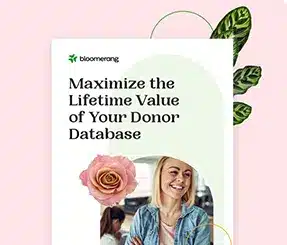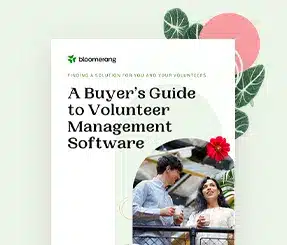The Essential Nonprofit Annual Report Template & Full Guide


Full Platform Overview Chat With Us



Full Platform Overview Chat With Us




Many nonprofit professionals greet the annual reporting process with apprehension. This is because nonprofit annual reports have a bad reputation. They’re often seen as a drain on time and resources.
However, you don’t need to dread the creation of your annual report! When well crafted, this resource can be a vital tool to retain and grow donor support.
This post is designed to guide your organization through the nonprofit annual report creation process. We’ll walk you through tips to make your report as effective as possible (with helpful templates along the way to provide formatting examples). Here’s what to expect:
Ready to dive a little deeper into nonprofit annual reports and learn how you can craft yours to maximize the impact at your organization? Let’s get started.
A nonprofit annual report is an externally-facing resource that recaps an organization’s accomplishments and challenges within a year. The audience for this report is the donors, volunteers, constituents and other stakeholders who have been involved with the organization’s projects and programs throughout the year.
Traditionally, this report was a printed document or brochure shared with relevant stakeholders. Nowadays, annual report formats vary widely. They can be presented as PDFs, videos, interactive web pages, online booklets or in other unique formats.
In short: no. You may be thinking of Form 990 — every year, nonprofits are required to submit a Form 990 to the IRS. This document contains information about your nonprofit’s revenue and expenses throughout the year. Because this information is publically available, supporters can use your nonprofit’s annual Form 990 to track your financial transparency.
Technically, Form 990 is the only required annual report for nonprofits. However, your annual tax form doesn’t thank your donors, make them feel proud or give them new reasons to engage and grow their relationship with you. A comprehensive annual report can fill this role. That’s why we highly recommend including a full-fledged annual report in your annual strategy.
So, what should a nonprofit annual report include? Here is a basic template that can provide a starting point for building your annual report strategy:
As shown in the template, your annual report should include the following elements:
Since there is no legal requirement for nonprofits to publish annual reports, there are no specific guidelines for what you must include in your report. However, if you completely omit your financial information from your report, for instance, some supporters may consider it fishy. Promoting full transparency is key to maintaining donor trust and your nonprofit’s reputation.
Now that you have a basic understanding of the elements of an annual report, you can build on your approach to make the report as engaging and effective as possible. Here are a few best practices to keep in mind when developing your nonprofit’s annual report:
Your annual report will provide the greatest long-term benefits when it supports a larger goal and strategic plan for your organization. You can recoup the time and resources spent creating the report by turning this report into a valuable donor engagement and retention tool.
For example, you can use your annual report to bolster your fundraising strategy. You can support your donor retention efforts by spotlighting top donors and partners in your report and highlighting exciting upcoming initiatives for supporters to get involved with.
You can also use the report to further your marketing approach. Consider the core messages your organization has pushed throughout the year. How can you incorporate those same messages, tone and visuals into your annual report?
Carefully thinking through the purpose of your annual report will help you create a resource that reinforces and supports your other strategic goals.
Your annual report should be donor-centric to reach your audience on a personal level. Review these strategies for keeping your report centered on your supporter community:
Your annual report’s format is a key decision to make and you can base the choice on what you anticipate your audience will read. Understanding your audience demographics and preferences is the first step to ensuring your annual report is designed for their needs.
You may have some donors who want all of the details about your organization’s efforts as soon as possible. They value and appreciate a book-style annual report with detailed stories, infographics and charts.
You may also have some donors who won’t sit down to read your newsletter, much less a lengthy annual report. You may consider sending a single page of infographics rather than a full report to these donors.
A you-attitude is all about presenting accomplishments as your donors’ rather than your organization’s. Try to keep supporters centered at all times. For instance, compare the following sentences:
Versus
The second sentence uses you-attitude and is more likely to hold the attention of your supporters throughout a document like your nonprofit annual report. This subtle shift lets the donor know you’re truly grateful for their support.
It can be overwhelming to pick up a large packet of information with pages and pages of text. Instead, break up the text with infographics, graphs and charts, images of supporters and volunteers and other interesting graphics.
Visuals make it easier for supporters to scan your nonprofit annual report and pull out the data that means the most to them.
The traditional nonprofit annual report is a book-length document. Since some donors prefer having extensive information about your organization, these lengthy reports aren’t a waste of time and energy.
Sending comprehensive annual report booklets to the right donors can pay off, like in the case of The Rhode Island Foundation. This organization published a well-designed, well-written report. They cut down on the number of reports they mailed directly (and made the report available online) but made sure to continue sending the paper version to some local lawyers.
An elderly man walked into the office of one of these local lawyers, prepared to write a will and get his affairs in order. While he waited to be seen, he picked up one of the copies of the Rhode Island Foundation annual report. He hadn’t quite known what to do with his sizable estate before that moment. Years later, upon his passing, the Rhode Island Foundation received a small fortune from that generous man, all thanks to a printed annual report.
This story illustrates the benefits of a traditional report format. However, this doesn’t mean you shouldn’t adapt to the times. Analyze your audience and create your annual report according to what they’re most likely to respond to.
Remember that you can always post your full report online and use other formats to summarize information and invite your supporters to visit your website to view the entire document. For example, let’s review some other unique formats that you may use to convey your annual report:
Postcards are designed to be brief so that supporters can quickly and easily skim the information rather than read a lengthy document (or book). Your goal shouldn’t be to jam-pack this postcard with all of the information that you would include in a traditional report. Instead, you should highlight only the most important details.
Your postcard should:
While you may not have the opportunity to include every detail in this format, you can leverage additional platforms alongside your postcard. For example, you may leave out appreciation messages for major donors in your postcard, but include a QR code leading to a virtual donor recognition wall to show your gratitude in another way.
Here is a template for what your annual report postcard might look like:
This template includes financial information, a short summary of the accomplishments during the year and key statistics that reveal the organization’s impact.
Another option for sending your nonprofit annual report is creating a 2-4 page document self-mailer. Self-mailers can be incredibly useful because they bypass the issue of getting your supporter to open an envelope in the first place since the address and postage are printed directly on the document. It’s easy for your supporters to simply open the document and read what it says.
Follow these best practices when designing a self-mailer:
While this type of nonprofit annual report is designed to be physically mailed, it’s also a good idea to send a PDF version via email to gain the attention of those who might have missed it in their mailbox.
Here is an example of what your self-mailer could look like. It contains the same information we highlighted in the postcard, but in a multi-page format:
A well-designed, compelling video is a great way to not only tell your supporters but also show them the impact they made on your organization’s mission. Follow these steps to create an effective video:
You can share your video report on your website, social media and email newsletters.
Your report’s images and graphics should be thoughtfully chosen. Here are a few examples of the types of visuals you might include in your annual report:
Images should never be distracting. They should be helpful guides when it comes to conveying important information within your nonprofit annual report.
Ask for volunteers to review the document and provide feedback about the imagery used before you send your report out. Or, you might hire a professional graphic designer to help organize all of the information in a visually compelling way.
Honesty really is the best policy, especially in your nonprofit annual report.
Sometimes things don’t go as planned and you may not reach a specific goal or complete a certain project. However, if you try to cover up mistakes or missed opportunities, you can foster mistrust among supporters.
If you haven’t quite accomplished one of your goals within the last year, briefly mention it in the annual report. Then, follow it up with a game plan to adjust your strategy and show your donors that you’re taking a proactive approach.
Address information such as:
Stay transparent about all of your nonprofit’s activities, including finances, campaign results and external threats, such as any data breaches you may have experienced.
Providing information about your future plans and projects will get people excited about what’s in store for your nonprofit.
When looking forward, make sure to spell out the expectations regarding your organization’s future actions and goals:
Forward-facing plans excite your donors and inspire them to continue contributing in the future.
Make sure that after you’ve provided insight about your future plans, you also provide opportunities for your supporters to get involved. Provide some action items that supporters can take part in right away, such as the URL to your donation page, meeting dates and upcoming event registrations so that they can show their support.
You don’t need to be a graphic design expert or set aside a large amount of your budget to build a compelling annual report. There are plenty of free and inexpensive ways to develop your report using user-friendly online resources.
A few helpful design tools for creating your annual report include:
Choose your annual report platform based on the report formats you’re looking to create. Also, take advantage of any free trials or demos before investing in paid plans.
It can be intimidating and hard to get started on a project when you’re just looking at a blank page. That’s why it can be so helpful to review examples to help get you started on your nonprofit annual report.
Here are seven inspirational nonprofit annual reports and the factors that make them so effective:
Feeding America’s 2023 Annual Report is a classic example of the traditional PDF annual report format. However, the nonprofit elevates this basic format with eye-catching graphic design and engaging imagery.
In the screenshot above, you can see an example of the unique way the nonprofit depicts its annual financial statement. The organization cleverly ties in its mission with the use of food imagery, giving readers a more engaging way to explore the nonprofit’s financial situation.
Elsewhere throughout the report, images showing the smiling faces of supporters, volunteers, and beneficiaries help foster an emotional connection and provide greater visual intrigue.
The Leukemia & Lymphoma Society’s (LLS) 2023 Annual Report theme is “Transforming Lives.” The organization uses this theme to tell the stories of patients supported throughout the year, from a veteran who survived blood cancer to a student-athlete who received successful treatment.
The report accurately illustrates LLS’ approach to 360-degree support for beneficiaries. Through colorful graphic design and a cohesive theme, readers can get a complete overview of the organization’s successes and financials from the past year.
The World Wildlife Fund’s (WWF) 2023 Annual Report is rife with engaging imagery showcasing the organization’s conservation mission. The report switches back and forth between stories that highlight both global and local impacts of the organization’s conservation work. This format gives readers a better sense of the scale and scope of WWF’s projects and the different types of ecosystems they support.
At the end of the post, readers can dive into the nonprofit’s statement of activities, including a clear breakdown of operating revenues, expenses, and other financials. The report also includes a detailed list of ways to give, allowing readers who feel inspired after reading the report a clear way to show their support.
The Rhode Island Foundation annual report is a booklet document that takes a deep dive into the various projects and campaigns from the year. Primarily, they use pictures of supporters, beneficiaries and team members to bring their mission to life.
On the page above, we can see how the foundation used charts and spacing effectively. Rather than including these statistics in the paragraph-style text on the left side of the page, they’re pulled out and made larger and more prominent. This draws the readers’ attention to the most important data points and conveys the organization’s impact more effectively.
The Georgia River Network is an organization that promotes the protection of Georgia’s rivers and watersheds. At the end of 2022, the organization released a brief Annual Report 2022 video with a few key statistics of the progress made throughout the year.
In the video above, you can see how the organization used bold text and lots of white space to make the numbers stand out. The video’s caption includes a call to action to support the nonprofit’s projects and programs in 2023 by donating. This gives supporters a clear way to stay involved in the organization’s future activities.
The stand-out quality of the American Heart Association’s most recent annual report is its comprehensiveness. Anyone picking up this report, whether a donor, beneficiary, or community or corporate partner, is met with a thorough overview of where the organization currently stands.
The organization’s top priorities, from improving rural health to fueling scientific research, are detailed in-depth. Maps, charts, statistics, and images are available to enhance readers’ understanding of the issues.
The report also pays homage to one of the most important groups of nonprofit donors: corporate sponsors. Each major corporate sponsor is given a specific mention and description of how they’ve supported the mission.
CaringBridge is a nonprofit that helps people stay in touch with their loved ones during a health journey using websites and digital updates.
The organization’s 2022 annual report does an excellent job of combining images, text, statistics and stories. As you can see in the image above, they even provide QR codes throughout the report for readers to scan and get more information on stories that spark their interest.
This allows readers to engage with the parts of the report that matter most to them and interact with the report on their mobile devices.
Habitat for Humanity’s 2023 annual report takes a unique spin on illuminating the organization’s mission to provide affordable housing for those in need. Rather than a traditional PDF format, the report is a compelling web page full of text, videos, images, and other multimedia elements that bring the organization’s mission to life. The page uses engaging elements such as bold statistics, pullout quotes, and parallax scrolling to draw readers into the content.
The report also includes a convenient, sticky top-level menu that allows readers to browse the page more easily and jump to different sections that interest them.
Many nonprofits are taking a digital-first approach to their annual report, including Girls Who Code.
The organization’s 2021 annual report is an interactive, engaging web page that includes infographics and interactive maps, videos, photos, and news articles. The result is a visually delightful report that provides a well-rounded look at the organization’s mission to teach girls how to code.
Save the Children’s 2021 annual report also takes an effective digital approach, with a robust web page that features financial information, a year-in-review video, and a link to the full 50-page annual report.
This gives supporters multiple ways to view the report based on their preferences. If they’re just interested in a quick overview, they can view the financial chart and watch the brief video. If they’re looking for a more in-depth review of the year, they can browse through the digital booklet.
Supporters appreciate having options when it comes to how they learn more about a nonprofit’s activities.
Your nonprofit’s annual reports will receive much more attention when they’re thoughtfully crafted, compelling, and well-designed. Ensuring that your report is engaging and educational for your supporters will go a long way in building stronger, long-lasting relationships.
The templates and annual report examples throughout this article should help your nonprofit get started making your annual report the best it can be. If you’re looking for more information about donor communications and effective nonprofit reporting, check out these additional resources:
Comments